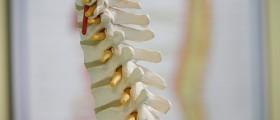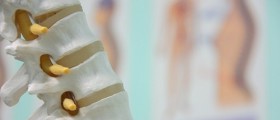
Spine and its discs
The spine is the axis of the skeletal system. It is unique in the structure. It is made of vertebrae, cylindrical bones that are stacked into a flexible column. Vertebrae are reinforced by very strong ligaments, and the joints between the vertebrae are of such construction that they allow movement such as bending, Flexing and rotating. Few other joints can do this, and certainly no other skeletal structure can move in such a way. The joint between the vertebrae is unlike other joints, as it has more than just cartilage on the end of bones and lots of ligaments. Between the vertebrae, there is a structure known as a disc. It is what cushions the vertebrae and allows for the incredible flexibility of the spine (think yoga, or cats). Shaped somewhat like a lens, it consists of an elastic outer layer filled with gel.
If the disc ruptures
Disease, injury or normal age related wear and tear may cause a disc to rupture or to bulge. Such disc is regarded as a herniated, slipped or ruptured disc. Injury to the outer layer of the disc can painful but more often than not there is no discomfort related to the herniated disc itself. Problems (and pain) arise from nearby nerve roots or spinal cord, that are subjected to pressure from the bulge or from the seeped gel. The region of the body innervated by the compressed nerve may be numb and painful, since the signal is not interpreted as a misfire in the nerve caused by pressure but as pain in the area for which the troubled nerve is responsible.
Symptoms of a herniated disc
A herniated disc frequently goes by unnoticed as there are no particular symptoms such as inexplicable pain in the leg or in the back, and experienced symptoms can vary quite significantly, depending on the location of the herniated disc and affected nerves. For example, if the nerve root is not pressed, there could be no symptoms at all, or only a weak backache. Pressure on the nerve will cause pain or numbness in the area of the body innervated by the nerve. A ruptured disc in the neck may cause pain or numbness in the shoulders, arms or in the chest. Pressure on one of the five roots of the sciatic nerve may cause sciatica.
Pressure on the nerves also causes the sensation of pins and needles, tingling, numbness and weakness.
Surgery
There are several surgical procedures for treatment of a ruptured disc, but a conservative approach is preferred. Laminectomy removes the lamina on the selected vertebrae and any thickening in the spinal channel. Discectomy is used to remove the ruptured disc itself, and is used when no other method of therapy is effective. Laminotomy is a minimally invasive procedure used to open the spinal canal and relieve pressure.















-Causes,-Symptoms,-Diagnosis,-Treatment_f_280x120.jpg)

Your thoughts on this
Loading...